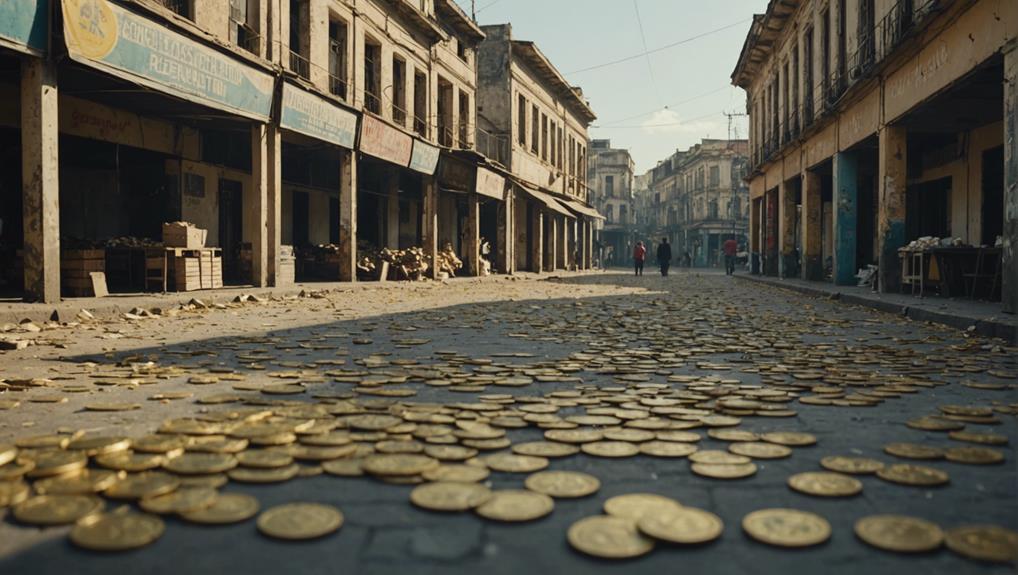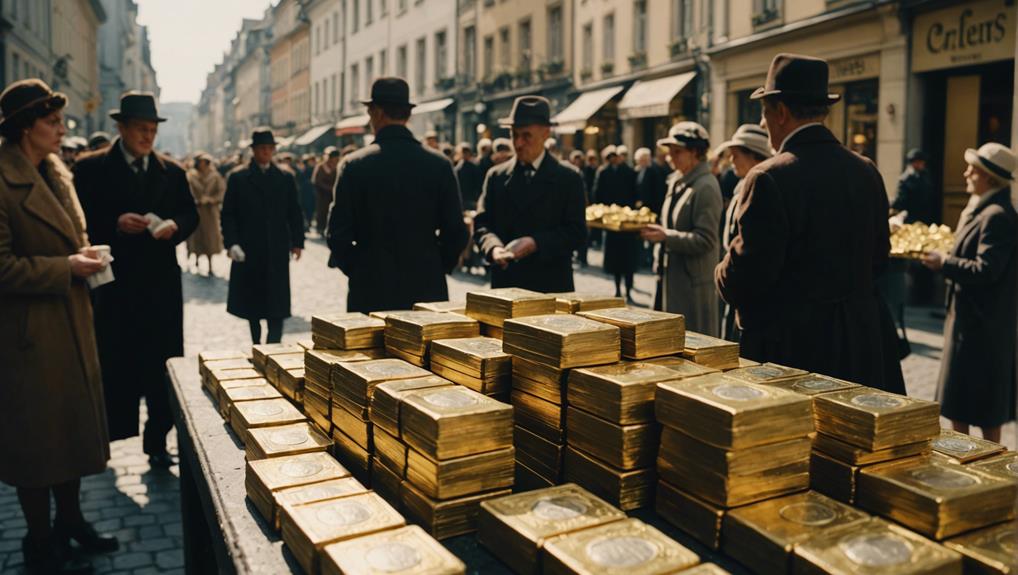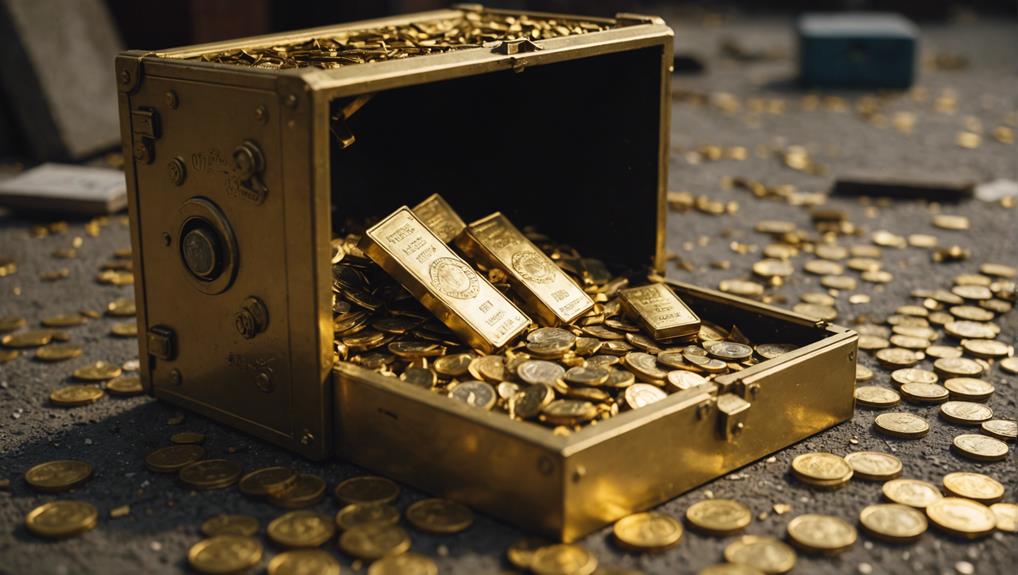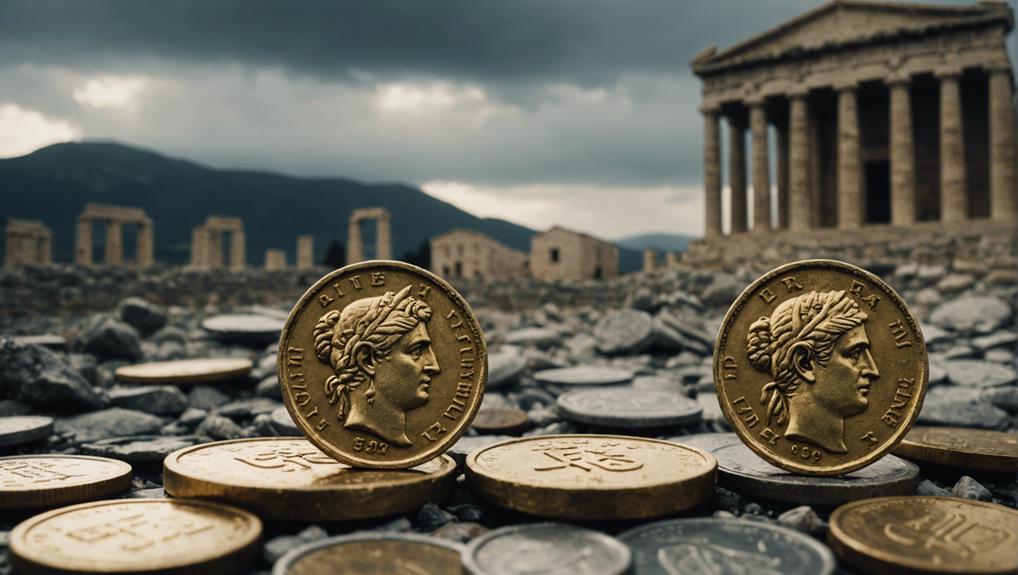Historical Case Studies of Gold's Performance During Hyperinflationary Episodes
During episodes of hyperinflation, such as those experienced in Weimar Germany, Zimbabwe, and Venezuela, gold has historically performed as a robust safe haven asset. In these crises, while local currencies plummeted in value, gold preserved purchasing power and offered financial stability. For instance, as the Zimbabwe Dollar collapsed, those who had invested in gold managed to safeguard their wealth. In Weimar Germany, gold emerged as a reliable asset amidst economic chaos. This trend underscores gold's global reputation as a hedge against extreme inflation. Exploring these case studies further could provide valuable insights into asset protection in turbulent economic times.
Gold's Role in Weimar Germany

During the hyperinflation in Weimar Germany, gold emerged as a crucial stabilizer for personal wealth in the rapidly devaluing Reichsmark. As prices skyrocketed daily, those who invested in gold preserved their purchasing power. Unlike Reichsmarks, which plummeted in value, gold maintained its worth globally.
This precious metal became a reliable asset in the midst of economic chaos. You could exchange gold for a stable foreign currency or use it for bartering, providing a lifeline when paper money failed. Historically, this period highlighted gold's role as a hedge against inflation.
Zimbabwe's Hyperinflation Crisis

As you investigate Zimbabwe's hyperinflation crisis, it's vital to comprehend the collapse of the Zimbabwe Dollar. This catastrophic economic event spurred significant recovery efforts, attempting to stabilize the nation's financial system.
Let's analyze how these factors influenced the performance of gold during this turbulent period.
Zimbabwe Dollar Collapse
In the face of Zimbabwe's hyperinflation crisis, the Zimbabwe Dollar collapsed, drastically reducing its purchasing power. You'd have witnessed prices doubling nearly every day, making the currency nearly worthless.
As hyperinflation peaked, the rate reached an unimaginable 79.6 billion percent month-on-month in November 2008. This extreme devaluation forced you to switch to transactions in foreign currencies, unofficially sidelining the local money.
Savings and pensions stored in Zimbabwe Dollars evaporated, leaving many in poverty. Daily necessities became luxuries as the prices soared out of reach. This crisis wasn't merely numbers; it was a stark reality where carrying wheelbarrows full of money to buy basic items became a common sight, profoundly altering everyday life.
Economic Recovery Efforts
Zimbabwe initiated several recovery efforts to stabilize its economy and curb the rampant hyperinflation that had devastated its financial system. They ditched the Zimbabwe dollar in 2009, adopting a multi-currency system primarily reliant on the US dollar and South African rand. This move helped restore some measure of price stability and slowed inflation. Moreover, you'd see the government implement fiscal austerity measures to reduce budget deficits and regain international confidence.
Furthermore, efforts to stimulate economic growth involved re-engaging with international lenders and reforming investment laws to attract foreign direct investment. Although these steps provided some relief, the road to full economic recovery remains challenging, with ongoing currency issues and the need for further structural reforms.
Venezuela: Recent Economic Collapse

As you investigate the recent economic collapse in Venezuela, you'll find that gold played a critical role amid the rampant hyperinflation. The impact on the gold market was significant as citizens turned to this precious metal as a stable store of value.
Meanwhile, the effects of currency devaluation dramatically reshaped financial interactions within the country.
Gold Market Impact
Venezuela's recent economic collapse significantly impacted the gold market, as investors sought stability during soaring inflation. You'd have noticed that in the middle of the economic turmoil, gold prices surged. This wasn't merely about a local scramble for security; it had ripples across the global markets.
Investors worldwide turned their attention towards gold as a safe haven, pushing demand higher than usual. This increased demand led to a notable uptick in gold prices globally, impacting not only investors but also miners and retail buyers.
As you explore further, you'll find that the crisis underscored gold's role as a crisis asset, proving its value in maintaining value when other assets falter. This situation provides a clear example of gold's reliability in times of economic uncertainty.
Currency Devaluation Effects
During Venezuela's economic collapse, the bolívar faced severe devaluation, drastically reducing its purchasing power and driving investors to seek refuge in more stable assets like gold. You'd notice the trend as gold's value soared in relation to the plummeting bolívar. This shift wasn't simply a panic reaction; it was a strategic move to preserve wealth in a tangible form that could withstand currency crises.
| Year | Bolívar to USD Exchange Rate | Gold Price in Bolívars |
|---|---|---|
| 2015 | 900 | 450,000 |
| 2016 | 10,000 | 5,000,000 |
| 2017 | 100,000 | 35,000,000 |
| 2018 | 1,000,000 | 300,000,000 |
| 2019 | 10,000,000 | 3,000,000,000 |
As the table shows, the bolívar's devaluation accelerated, making gold a critical asset for maintaining value during economic uncertainty.
Hyperinflation in 1920s Austria

Hyperinflation ravaged Austria in the 1920s, dramatically eroding the value of its currency. You'd see prices doubling within days, sometimes hours. This financial chaos wasn't simply numbers on paper; it deeply affected everyday life. Imagine needing a wheelbarrow full of cash simply to buy bread.
Amid this turmoil, gold emerged as a savior for many. Its value didn't plunge like the Austrian krone; instead, it soared, retaining purchasing power remarkably well.
As you'd expect, Austrians rushed to convert their savings into gold, which became a stable asset in unstable times. This move wasn't merely a panic reaction but a strategic shift to preserve wealth. Even today, gold's resilience during such periods remains a critical lesson in safeguarding assets against inflation.
Hungary After World War II

Like Austria, Hungary experienced severe hyperinflation after World War II, with the Hungarian pengő losing nearly all of its value.
You'd find that during this period, everyday items became astronomically expensive, pushing people to seek stable alternatives like gold.
As the pengő plummeted, gold's value soared, serving not merely as a hedge, but as a crucial survival tool. Citizens who'd invested in gold before the inflation hit managed to preserve their wealth and could even use their holdings to barter for necessities.
This scenario underscores gold's role as a robust store of value when currency stability is shattered. Observing Hungary's ordeal, you'd see the clear benefits of holding tangible assets during economic crises.
Yugoslavia's Inflation Spiral

Yugoslavia entered a devastating inflation spiral in the early 1990s, severely impacting its economy and the daily lives of its citizens. As you investigate this period, you'll find that the inflation rate skyrocketed, reaching unfathomable levels. The national currency became practically worthless, forcing people to barter or use foreign currencies for everyday transactions.
Here's a brief breakdown of significant figures during this period:
| Year | Inflation Rate | Impact on Gold Value |
|---|---|---|
| 1992 | 313% | Substantial increase |
| 1993 | 1,134% | Rapid increase |
| 1994 | 2,178% | Sky-high surge |
These numbers illustrate just how chaotic the economic conditions were, prompting a desperate turn to more stable investments like gold.
The Argentine Economic Meltdown

Argentina's economy faced a severe meltdown in the late 1990s and early 2000s, marked by rampant inflation and financial instability. You'd witness the country grappling with an unsustainable debt burden, leading to a default in 2001—the largest in history at that time. As banks shuttered and savings accounts were frozen to stave off capital flight, people's trust in the Argentine peso plummeted.
In this chaos, gold emerged as a safe haven. As the peso's value nosedived, gold prices in local currency terms soared. Investors and ordinary citizens alike turned to gold, not merely as a wealth preserver but as a practical alternative for everyday transactions. This shift underscores gold's enduring appeal during times of economic crisis, where traditional currencies falter.
Brazil's Inflation Control Measures

In response to escalating inflation, Brazil implemented a series of robust measures to stabilize its currency and control price escalations. They anchored these efforts in the early 1990s with the introduction of the Real Plan. This plan sought to curb hyperinflation by replacing the old currency with the Real and tightly controlling the money supply. They furthermore pegged the new currency to the U.S. dollar to assure stability.
Moreover, Brazil enforced strict fiscal policies, including significant cuts in government spending and reforms in public sector administration. These actions not only halted inflation rapidly but also restored public confidence in the economy. As a result, these measures significantly influenced Brazil's economic landscape, fostering a period of substantial growth and stability.
Lessons From the Greek Financial Crisis

The Greek financial crisis teaches us that excessive debt coupled with rigid fiscal policies can lead to severe economic downturns. As you explore this scenario, keep in mind that Greece's economic structure heavily relied on borrowed money. This dependency was unsustainable, especially when global financial conditions tightened.
The crisis underscored the importance of gold as a safe haven. While the Euro faltered, gold retained its value, offering a reliable asset in the midst of the chaos. You'd see that investors who diversified into gold mitigated their losses significantly compared to those who solely held traditional stocks or euros.
This historical example highlights gold's role as a protective hedge against currency devaluation and economic instability, reinforcing its value during financial upheavals.
Conclusion
When diving into the historical performance of gold during hyperinflation, it's clear this precious metal isn't just a relic but a robust safeguard against economic downturns. For instance, consider Zimbabwe's 2008 hyperinflation crisis, where gold prices skyrocketed by over 300%. This surge highlights gold's resilience as a financial sanctuary when currency values crumble.
The narrative around gold isn't just historical data; it's a beacon for those wanting more control over their financial destiny. Traditional banks and the broader monetary system often seem skewed towards the affluent, leaving everyday investors navigating rough waters with little support. Moreover, the trust in politicians to manage these systems is wearing thin. Gold offers a tangible asset that stands apart from the opaque maneuvers of financial institutions and political maneuvering.
For those of us skeptical about banks' intentions and the overall stability of the monetary system, investing in gold provides a sense of empowerment. It's an investment that you can see, touch, and feel, ensuring that you're the master of your wealth, not some distant institution or fluctuating market.
Thus, embracing gold isn't merely a financial strategy; it's a move towards greater independence and security in an unpredictable world. If you're ready to take control of your financial future, consider starting with our free gold information kit. It's your first step towards understanding how gold can't only preserve but also enhance your wealth.
Don't just take my word for it. Request your free gold information kit today from:
The Gold Information Network
11900 Biscayne Blvd, Ste 127B, Miami, FL 33181
(305) 449-9094
http://goldinfo.net
Take control, secure your assets, and ensure your financial future shines as bright as the gold you hold.
source https://rondewitt.com/historical-case-studies-of-golds-performance-during-hyperinflationary-episodes/
Comments
Post a Comment